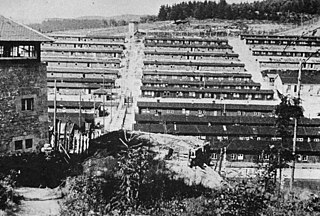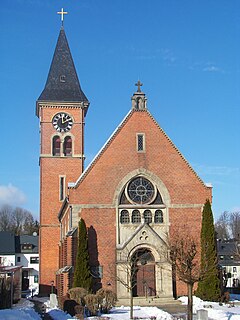
Flossenbürg was a Nazi concentration camp built in May 1938 by the SS Main Economic and Administrative Office. Unlike other concentration camps, it was located in a remote area, in the Fichtel Mountains of Bavaria, adjacent to the town of Flossenbürg and near the German border with Czechoslovakia. The camp's initial purpose was to exploit the forced labor of prisoners for the production of granite for Nazi architecture. In 1943, the bulk of prisoners switched to producing Messerschmitt Bf 109 fighter planes and other armaments for Germany's war effort. Although originally intended for "criminal" and "asocial" prisoners, after Germany's invasion of the Soviet Union, the camp's numbers swelled with political prisoners from outside Germany. It also developed an extensive subcamp system that eventually outgrew the main camp.

Aufseherin[ˈaʊ̯fˌzeːəʁɪn] was the position title for a female guard in the Nazi concentration camps during World War II. Of the 50,000 guards who served in Nazi concentration camps, about 5,000 were women. In 1942, the first female guards arrived at Auschwitz and Majdanek from Ravensbrück. The year after, the Nazis began conscripting women because of a shortage of male guards. In the context of these camps, the German position title of Aufseherin translates to (female) "overseer" or "attendant". Later female guards were dispersed to Bolzano (1944–1945), Kaiserwald-Riga (1943–44), Mauthausen, Stutthof (1942–1945), Vaivara (1943–1944), Vught (1943–1944), and at Nazi concentration camps, subcamps, work camps, detention camps and other posts.

Plauen is, with around 65,000 inhabitants, the fifth-largest city of the Free State of Saxony, Germany after Leipzig, Dresden, Chemnitz and Zwickau, the second-largest city of the Vogtland after Gera, as well as the largest city in the Saxon Vogtland. The city lies on the Whiter Elster River, in the Central Vogtlandian Hill Country. Plauen is the southwesternmost city of a string of cities sitting in the densely populated foreland of the Elster and Ore Mountains, stretching from Plauen in the southwest via Zwickau, Chemnitz and Freiberg to Dresden in the northeast. It is the capital of the Vogtland District. Plauen borders Thuringia to the north, and it is also situated near the Saxon border with Bavaria (Franconia) and the Czech Republic (Bohemia).

Kraslice is a town in Sokolov District in the Karlovy Vary Region of the Czech Republic. It has about 6,700 inhabitants.

Nossen is a town in the district of Meissen, in the Free State of Saxony, Germany. It is located 80 km southeast of Leipzig. The town is dominated by a large Renaissance castle. Nossen is best known for its proximity to a motorway junction where the A14 merges onto the A4.

Helmbrechts is a town in the district of Hof, in Bavaria, Germany. It is situated on the Southern edge of the Frankenwald, 20 km southwest of Hof.

Flöha is a town in the district of Mittelsachsen, in the Free State of Saxony, Germany. Flöha is situated on the confluence of the rivers Zschopau and Flöha, 10 km (6.21 mi) east of Chemnitz.

Lengenfeld is a town in the Vogtlandkreis district, in the Free State of Saxony in eastern Germany. The town is situated 19 km southwest of Zwickau, and 18 km northeast of Plauen.

Saal is a municipality in the district of Kelheim in Bavaria in Germany. It is located along the banks of the Danube River, around 25 km southwest of Regensburg.

Teugn is a municipality in the district of Kelheim in Bavaria in Germany.

Happurg is a municipality in the district of Nürnberger Land in Bavaria in Germany. During World War II, a subcamp of Flossenbürg concentration camp was located here.
Tadeusz Sobolewicz was a Polish actor, author, and public speaker. He survived six Nazi concentration camps, a Gestapo prison and a nine-day death march.

Neurohlau was a subcamp of Flossenbürg concentration camp, mainly for women prisoners of several European nationalities including Czech, Soviet, Yugoslavian, Belgian, Polish, and German. It was located on the edge of the municipality Neurohlau in the historical territory of Sudetenland. The Germans founded the camp in the autumn of 1942 and closed it in April 1945. Its main purpose was providing workers for the nearby Bohemia porcelain factory. At least 41 prisoners died in the camp ; about 500 died during the death march out in April 1945; an unknown number died after their deportation back to the mother camps ; and some others were burnt in the camp in Karlovy Vary. After World War II, the camp served as a collecting camp for prisoners of war before their removal to Germany.

Subcamps, also translated as satellite camps, were outlying detention centres (Haftstätten) that came under the command of a main concentration camp run by the SS in Nazi Germany and German-occupied Europe. The Nazis distinguished between the main camps and the subcamps subordinated to them. Survival conditions in the subcamps were, in many cases, poorer for the prisoners than those in the main camps.

During World War II, the German Luftwaffe staffed dozens of concentration camps, and posted its soldiers as guards at many others. Camps created for the exploitation of forced labor for armaments production were often run by the branch of the Wehrmacht that used the products. The Wehrmacht also posted about 10,000 soldiers to concentration camps because of a shortage of guards in mid-1944, including many from the Luftwaffe.

Leitmeritz was the largest subcamp of the Flossenbürg concentration camp, operated by Nazi Germany in Leitmeritz, Reichsgau Sudetenland. Established on 24 March 1944 as part of an effort to disperse and increase war production, its prisoners were forced to work in the caverns Richard I and II, producing Maybach HL230 tank engines for Auto Union and preparing the second site for intended production of tungsten and molybdenum wire and sheet metal by Osram. Of the 18,000 prisoners who passed through the camp, about 4,500 died due to disease, malnutrition, and accidents caused by the disregard for safety by the SS staff who administered the camp. In the last weeks of the war, the camp became a hub for death marches. The camp operated until 8 May 1945, when it was dissolved by the German surrender.

Gusen was a subcamp of Mauthausen concentration camp operated by the SS between the villages of Sankt Georgen an der Gusen and Langestein in the Reichsgau Ostmark. Primarily populated by Polish prisoners, there were also large numbers of Spanish Republicans, Soviet citizens, and Italians. Initially, prisoners worked in nearby quarries, producing granite which was sold by the SS company DEST.

The Regensburg satellite camp, also known as the Colosseum subcamp in the vernacular at the time, was established in 1945 as the last subcamp of the Flossenbürg concentration camp in the Regensburg inn the Kolosseum. The Regensburg subcamp was in operation from March 19, 1945 until April 23, 1945. The Colosseum building is located at Stadtamhof 5, approximately 200 meters north of the Danube across the Stone Bridge from the Altstadt.




















